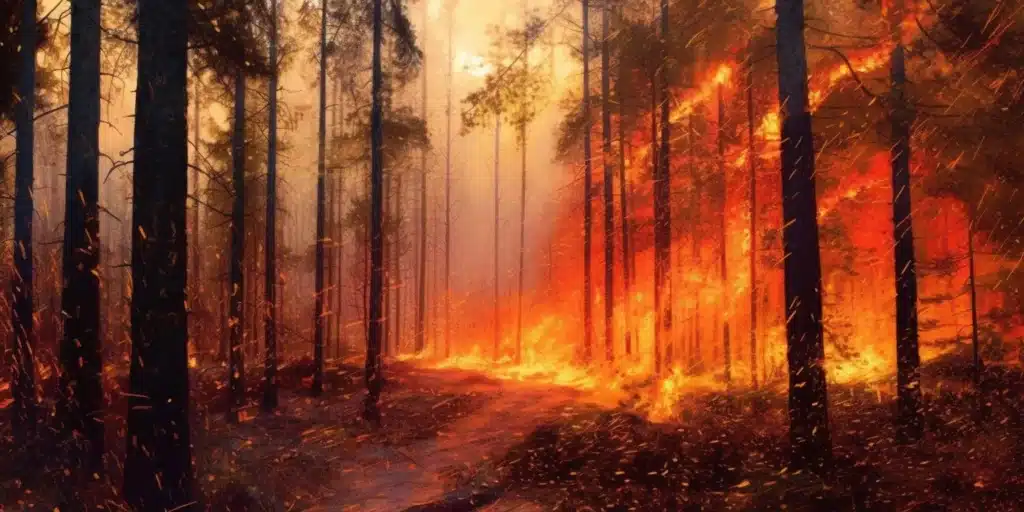When it comes to combatting forest fires, early detection and precise monitoring can mean the difference between minor damage and a major ecological catastrophe. Unmanned Aerial Vehicles (UAVs), with their potential for providing timely, precise, and accurate information, are steadily transforming the field of forest fire detection and monitoring. This article ventures into the fascinating domain of UAVs for forest fire detection and monitoring, a realm where cutting-edge technology meets urgent ecological need. Here we will explore how these aerial wonders are leveraged for early fire detection, and how affordable UAV solutions contribute to a more effective and efficient fire response.
Understanding UAVs
Unmanned Aerial Vehicles (UAVs), popularly known as drones, have been revolutionizing numerous sectors, with applications ranging from aerial photography and agriculture to humanitarian aid and now, forest fire detection and monitoring.
A UAV is essentially an aircraft without a human pilot onboard. It can either be remotely controlled by a human operator or fly autonomously using pre-programmed flight paths. They are equipped with various types of technology such as infrared cameras, Global Positioning System (GPS), lasers, and other specialized sensors that allow them to perform a variety of tasks efficiently and with precision.
UAV Component | Description |
Airframe | The structure of the UAV, including the wings, body, and tail. |
Propulsion system | Allows the UAV to move and stay in the air; typically includes electric motors or combustion engines. |
Flight control system | Manages the flight path of the UAV; can be operated manually or autonomously. |
Payload | The equipment carried by the UAV for specific tasks, such as cameras or sensors. |
UAVs in Action: Forest Fire Detection
Moving into the specific context of forest fire detection and monitoring, UAVs are redefining the way we address this global issue. They offer distinct advantages over traditional methods, proving themselves as an essential tool in the battle against forest fires.
What are UAVs used for in forest fire detection?
In forest fire detection, UAVs are employed for aerial surveillance and monitoring. Equipped with high-resolution cameras and thermal imaging sensors, they can spot even the smallest of fires from a safe distance. Their ability to rapidly cover large areas makes them perfect for this task.
How do UAVs help in monitoring forest fires?
Once a fire has been detected, UAVs can be used to continuously monitor its progression. They provide real-time visual information, map the extent of the fire, identify hotspots, and help firefighting teams strategize their actions more effectively. UAVs also play a crucial role in assessing the post-fire situation, providing valuable insights into the damage incurred and aiding in recovery efforts.
UAVs are specially designed to operate in challenging environments. They can safely fly over fire-affected areas, where it might be too dangerous for human teams or manned aircraft to approach. This makes them an invaluable tool in managing forest fires, contributing significantly to the safety and effectiveness of firefighting operations.
In the next section, we’ll dive deeper into the pros and cons of UAVs compared to traditional methods of forest fire detection and monitoring.
Pros & Cons: UAVs vs Traditional Methods
In the battle against forest fires, UAVs represent a new and innovative tool that brings its own set of advantages and challenges when compared to traditional methods. Let’s analyze some of the key aspects where UAVs stand out and areas where they might fall short.
What are the advantages of using UAVs over traditional methods?
UAVs hold several significant advantages over traditional methods:
- Early Detection: With their high-resolution cameras and thermal sensors, UAVs can detect fires at their nascent stage, allowing for prompt response.
- Real-time Data: UAVs provide live, up-to-the-minute data about the progression of fires, aiding firefighting teams in making informed, tactical decisions.
- Accessibility: They can access hard-to-reach areas that might be too risky or impossible for ground crews or manned aircraft to reach.
- Cost-Effectiveness: In the long run, UAVs tend to be more cost-effective than manned aircraft, as they require less fuel and manpower.
- 24/7 Operation: Unlike humans, UAVs don’t tire. They can operate day and night, offering round-the-clock fire monitoring.
Are UAVs effective in detecting fire hotspots? Can UAVs provide real-time data during forest fire emergencies?
Yes, one of the greatest advantages of UAVs is their ability to detect fire hotspots effectively and provide real-time data during emergencies. Equipped with thermal imaging sensors, they can identify and monitor areas where fire is most intense. This real-time data is invaluable in managing forest fire emergencies as it allows for quick and informed decision-making on the ground.
While UAVs are game changers in fire detection and monitoring, they’re not without their challenges.
Exploring UAV Technologies for Fire Monitoring
The effectiveness of UAVs in forest fire detection and monitoring hinges largely on the technology they’re equipped with. These technologies range from the sophisticated sensors that detect fires to the communication systems that relay real-time data to firefighting teams.
What type of sensors are used in UAVs for fire detection?
UAVs use a variety of sensors to detect and monitor fires. These include:
- Infrared Sensors: Detect heat signatures from fires, even in low-visibility conditions.
- Thermal Cameras: Identify and map hotspots, crucial for tracking fire spread.
- Multi-spectral Sensors: Gather data across different wavelengths, providing a comprehensive picture of the fire.
How do UAVs contribute to early fire warning systems?
UAVs play a critical role in early fire warning systems. Their high-resolution cameras and infrared sensors can detect the faintest signs of smoke or changes in vegetation health, often indicating a fire’s onset. This information can be rapidly relayed to firefighting teams, enabling a swift response to prevent the fire from spreading.
In the next sections, we will delve deeper into the cost-effectiveness of UAVs compared to traditional monitoring methods and the challenges that UAVs face in forest fire detection.
Evaluating the Cost-Effectiveness of UAVs
The utilization of UAVs for forest fire detection is not just about technological superiority; it’s also a matter of cost. When dealing with the economic aspects of fire management, decision-makers must consider the affordability and cost-effectiveness of their tools.
Are UAVs cost-effective compared to other monitoring methods?
Affordable UAV solutions for fire monitoring are becoming increasingly prevalent as the technology matures. While the upfront cost of a UAV system can be higher than traditional methods, the long-term savings are considerable:
- Manpower Reduction: UAVs, being autonomous, require fewer personnel for operation and monitoring.
- Maintenance and Operation: Compared to manned aircraft, UAVs have significantly lower fuel and maintenance costs.
- Damage Mitigation: By detecting fires early, UAVs can help prevent large-scale fires, potentially saving millions in firefighting costs and damage repair.
However, to gain a holistic view of UAVs’ cost-effectiveness, we must also consider the challenges that could potentially offset these benefits.
Unraveling the Challenges of UAVs in Fire Detection
While UAVs offer many advantages, their use in forest fire detection is not without limitations. Understanding these challenges is crucial for optimizing their deployment and anticipating issues that might arise.
What are the limitations of using UAVs in forest fire detection?
The main limitations of using UAVs in forest fire detection include:
- Regulatory Constraints: UAV operations are subject to various regulations regarding airspace, flight altitude, and operation during nighttime or beyond visual line of sight.
- Technical Limitations: Poor weather conditions can hinder UAV operations. Furthermore, despite advancements, battery life remains a concern for extended operations.
- Data Overload: While UAVs can collect vast amounts of data, processing this data in real time can be challenging.
Despite these challenges, UAVs have proven to be instrumental in not just fire detection, but also in post-fire analysis and recovery efforts. The next section will shed light on this important aspect of UAV-based forest fire management.
The Role of UAVs in Post-Fire Recovery
Beyond real-time fire detection and monitoring, UAVs also play an important role in post-fire analysis and recovery. These flying marvels of technology equip authorities with critical information necessary for damage assessment, strategic planning, and recovery efforts.
How can UAVs assist in post-fire analysis and recovery efforts?
After a forest fire has been contained or extinguished, the work is far from over. The recovery process begins, which involves a plethora of tasks including, but not limited to, assessing the extent of damage, evaluating the health of the remaining forest, planning reforestation efforts, and ensuring public safety.
UAVs can effectively support these activities in the following ways:
- Damage Assessment: UAVs equipped with high-resolution cameras and multispectral sensors can generate detailed images and maps of the affected areas, aiding in the assessment of fire damage.
- Soil Erosion and Landslide Risk: By creating detailed topographic maps and identifying changes in the landscape post-fire, UAVs can help predict and monitor soil erosion and the risk of landslides.
- Reforestation Planning: Using data collected by UAVs, forest managers can devise more effective reforestation strategies, deciding where and when to plant new trees.
Case Studies
UAVs have been successfully deployed in several instances for forest fire detection and monitoring. These case studies provide valuable insights into their efficacy and potential in managing forest fires.
Case Study 1: California Wildfires, USA
During the devastating wildfires in California in 2020, UAVs were extensively used for real-time surveillance and fire monitoring. The UAVs, equipped with thermal sensors, were able to identify and monitor fire hotspots, providing critical data to firefighting teams. Post-fire, UAVs were used to assess the damage and aid recovery efforts.
Case Study 2: Amazon Rainforest Fires, Brazil
In response to the severe fires that afflicted the Amazon Rainforest in 2019, UAVs were deployed to not only detect and monitor ongoing fires but also to collect data necessary for future fire prevention strategies. In the aftermath of the fires, UAVs played an instrumental role in evaluating the damage and strategizing recovery plans.
These case studies further solidify the role of UAVs in managing forest fires and demonstrate their potential for future implementations. In the next section, we will navigate through the regulations and training necessary for using UAVs in fire-prone areas.
Navigating Regulations and Training for UAV Usage
Operating UAVs, particularly in sensitive and potentially hazardous environments like forests prone to fires, requires a thorough understanding of regulations and permits. In addition, comprehensive training is necessary to ensure effective and safe operation of these machines.
Understanding Regulations and Permits
Regulations and permits for UAV operations can vary greatly from one region to another. However, there are certain commonalities that should be considered:
- Flight Permits: Many countries require UAV operators to obtain a special flight permit, especially when flying in sensitive areas or during emergencies like forest fires.
- No-Fly Zones: Areas of high sensitivity or high risk may be declared as no-fly zones, and flying UAVs in these areas could be heavily restricted or outright banned.
- Data Collection and Privacy: Any data collected using UAVs must be in compliance with local and national laws, including those relating to privacy and surveillance.
For specific regulations and permits, operators should consult with local authorities or relevant aviation agencies.
UAV Operator Training and Certification
Operating UAVs for forest fire detection and monitoring is not just about piloting the device. It involves a comprehensive understanding of the machine’s operation, including its fire detection technologies, interpreting the data it collects, and knowing how to respond based on that data.
Operators typically need to undergo rigorous training programs that cover:
- UAV Operation: Understanding the technical aspects of flying a UAV, including taking off, navigating, and landing safely.
- Emergency Response: Knowledge of protocols in response to data from UAVs, including alerting the necessary parties and coordinating with firefighting efforts.
- Data Analysis: Training on how to interpret and analyze data collected from UAVs, such as images and sensor readings.
In many places, operators may also need to earn certification proving their competency in these areas. The specific requirements can vary, so it’s important to check with the relevant local or national authorities.
Pioneering the Future: UAVs and AI in Fire Detection
The evolution of UAV technology and its role in fire detection doesn’t stop here. The future of this technology is being shaped by the integration of artificial intelligence (AI). This combination is anticipated to bring significant enhancements to fire detection and management strategies.
Role of Artificial Intelligence in UAV-based Fire Detection
AI can enhance UAV-based fire detection in various ways:
- Data Analysis: AI algorithms can help process and analyze vast amounts of data collected by UAVs, identifying patterns and making predictions that might be missed by human observers.
- Real-time Decision Making: AI can enable UAVs to make real-time decisions based on the data they are collecting. For instance, they could automatically adjust their flight paths to better monitor a rapidly spreading fire.
- Predictive Modeling: AI can help create models that predict the likelihood and spread of forest fires based on data collected by UAVs, improving prevention efforts.
Future Prospects of UAVs in Fire Prevention
UAVs are set to play an even more prominent role in fire prevention in the future. Potential advancements could include:
- Improved Sensor Technology: Advances in sensor technology could make UAVs even more effective at detecting fires and monitoring their spread.
- Greater Autonomy: With improvements in AI, UAVs could become increasingly autonomous, capable of carrying out complex tasks with minimal human intervention.
- Integration with other Systems: UAVs could become more integrated with other firefighting systems, providing a more coordinated and effective response to forest fires.
In the upcoming sections, we’ll discuss how to choose the right UAV for forest fire monitoring, evaluate their environmental impact, and integrate UAV data into existing fire management systems.
Selecting the Right UAV for Forest Fire Monitoring
Choosing the correct UAV for forest fire monitoring is a process that requires careful consideration of several key factors. The right UAV will be able to deliver the functionality required for efficient fire detection and monitoring while remaining within operational and budgetary constraints.
Identifying Needs and Specifications
Before starting the selection process, it’s essential to outline the specific requirements for the task at hand. These requirements could include:
- Flight Duration: How long does the UAV need to stay in the air for a single mission?
- Payload Capacity: What is the weight of the sensors and other equipment the UAV will carry?
- Range: How far can the UAV travel from the operator or base station?
- Data Collection: What types of data does the UAV need to collect? Is real-time transmission necessary, or can the data be stored onboard for later analysis?
- Environmental Factors: What weather conditions will the UAV need to operate in? How will it handle the heat and smoke from a forest fire?
Evaluating UAV Options
Once the needs and specifications have been established, it’s possible to begin assessing the available UAV options. During this evaluation process, potential UAVs can be compared based on the following factors:
- Performance: Does the UAV meet the required specifications for flight duration, payload capacity, range, and other key performance indicators?
- Reliability: How reliable is the UAV? How often does it need maintenance or repairs?
- Cost: What is the purchase price of the UAV? What are the projected costs for maintenance, repairs, and operation?
- Support and Training: Does the UAV manufacturer provide adequate support and training?
The best UAV for forest fire monitoring will vary depending on the specific needs and circumstances of the operator.
Environmental Impact and UAV Operations
While UAVs provide a powerful tool for forest fire detection and monitoring, it’s also necessary to consider their environmental impact.
UAV Operation and Wildlife
One of the potential impacts of UAV operations is the disruption of wildlife. Animals may perceive the noise or presence of a UAV as a threat, causing stress or prompting changes in behavior. Therefore, it’s essential to minimize interactions with wildlife whenever possible, such as by flying at higher altitudes, using quieter UAVs, or avoiding areas with high concentrations of animals.
Carbon Footprint and Sustainable Operations
As with any technology, the production and operation of UAVs come with a carbon footprint. The size of this footprint will depend on factors such as the materials used in manufacturing, the energy source for the UAV’s operation, and the frequency and duration of flights.
Strategies to reduce the carbon footprint of UAV operations could include using renewable energy sources, optimizing flight paths for efficiency, and recycling or responsibly disposing of old equipment.
In the next section, we will discuss how to leverage the data collected by UAVs for effective fire management. We will delve into the integration of this data with existing fire management systems.
Leveraging UAV Data for Fire Management
The data collected by UAVs in fire monitoring missions is a valuable resource that can significantly improve fire management strategies when effectively integrated with existing systems.
The Value of UAV Data
UAVs provide unique, real-time data that can be instrumental in early fire detection, fire behavior prediction, and post-fire recovery planning. Some of the most valuable types of data include:
- Imagery: High-resolution aerial imagery can reveal early signs of fire and help monitor its progression.
- Thermal Data: Thermal sensors can detect heat spots that may indicate a fire’s presence, even in its earliest stages.
- Topographical Data: Detailed topographical data can aid in predicting a fire’s likely path and rate of spread.
Integration with Fire Management Systems
To be effective, the data collected by UAVs must be integrated into existing fire management systems. This integration involves several steps:
- Data Collection and Processing: The raw data collected by the UAV must be processed and transformed into a usable format.
- Data Analysis: The processed data is analyzed to extract meaningful insights. This could involve identifying potential fire hotspots or predicting a fire’s likely path.
- Decision Making: The insights gleaned from the data are used to inform decisions. For example, fire management teams might decide to focus their efforts on a particular area based on the data collected by the UAV.
- Action: The decisions made are put into action, such as dispatching firefighting teams or evacuating at-risk areas.
- Review: After the action has been taken, the results are reviewed to assess the effectiveness of the response and make any necessary adjustments.
In a world where climate change has increased the frequency and intensity of forest fires, UAVs present a beacon of hope. Their ability to provide quick, accurate and real-time data about fire detection and monitoring has revolutionized our approach towards combating these devastating disasters. With UAVs, we are now more equipped than ever to uncover and control forest fires before they spread uncontrollably.
If you’ve found this deep dive into UAVs for forest fire detection and monitoring fascinating, you might also be interested in our comprehensive guide on building and growing your drone business. Visit here to explore how the growing UAV technology is transforming not just forest fire detection, but also creating numerous business opportunities.
Remember, at Blue Falcon Aerial, we are committed to using advanced drone technology for the betterment of our world. If you need any drone services, please feel free to contact us. Our dedicated team is always ready to assist you.




